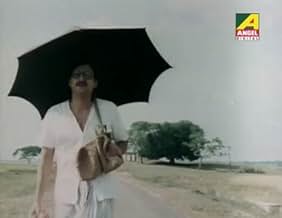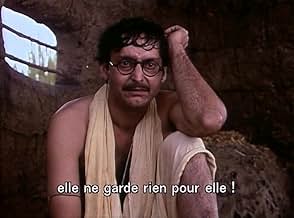IMDb RATING
7.9/10
1.8K
YOUR RATING
As food shortages reach catastrophic proportions, Gangacharan attempts to preserve his privileged situation while his generous wife Ananga conversely tries to help and support the community.As food shortages reach catastrophic proportions, Gangacharan attempts to preserve his privileged situation while his generous wife Ananga conversely tries to help and support the community.As food shortages reach catastrophic proportions, Gangacharan attempts to preserve his privileged situation while his generous wife Ananga conversely tries to help and support the community.
- Director
- Writers
- Stars
- Awards
- 4 wins & 2 nominations total
Soumitra Chatterjee
- Gangacharan Chakravarti
- (as Soumitra Chattopadhyay)
- Director
- Writers
- All cast & crew
- Production, box office & more at IMDbPro
Featured reviews
The subject matter of this small masterpiece is the famine which killed millions of people in Bengal during the war years after 1942 when Japan controlled Burma and a source of rice for India was then cut off. The "distant thunder" is the sound of an alien war, seemingly irrelevant, which nevertheless spreads its havoc. The central character is a Brahmin priest-teacher-doctor (Soumitra Chatterji) who with his wife (Babita)is forced to choose between survival for themselves or compassion for others less well-off than they are when confronted by scarcity, hoarding, and profiteering. Out of this background of horror and deprivation, the gifted director of the APU TRILOGY has fashioned a compassionate and understated picture leading inexorably to a haunting concluding image which must surely etch itself permanently into the memories and consciences of every viewer. This is a truly magnificent film.
DISTANT THUNDER is a very hard to find film (at least it was for me), so, if you see at your local library or film rental, don't pass up the chance to see it. It tells the story of the famine of 1943, in India, where a young Brahmin doctor (Soumitra Chatterji) and his beautiful wife (Babita) must search for rice, as the price continues to climb. The doctor is humbled by the experience and is forever changed (for the better) through experiencing, firsthand, what it feels like to be hungry. This is a beautiful masterpiece by the incomparable Satyajit Ray. If you haven't seen his films already, this is a great introduction. I also highly recommend THE APU TRILOGY, TWO DAUGHTERS, DEVI and THE STRANGER.
The chemistry between Chatterjee and Babita is amazing in this classic study of the conflicts between religion, station, and the inner workings of human souls. Ray's best-known masterpiece improves with repeated viewings. Every time, I watch it, I pick up new nuances, particular on Babita's performance. The thin lines between devout and callous, love and loathing, & heroism and insanity have never been examined more in-depth or with greater insights. On one level, great art, on another flawlessly technical, but overwhelmingly emotionally draining in the best possible way.
"Ashani Sanket", or "Distant Thunder", is one of the first color films of Satyajit Ray (probably my favorite film maker). It is a story about a young Brahmin couple, Gangacharan Chakravarti (played by Soumitra Chatterjee) and his wife Ananga (played by the simply named Babita), who come to settle in a rural and largely illiterate peasant community in India's eastern province of Bengal. Gangacharan takes up teaching and the occasional priestly duties, disparaging the backwardness of the people he is serving.
There are several scenes of military aircraft flying in formation; the villagers wonder how they can fly and remark at their beauty. But the planes are flying because of their participation in WWII, and soon people start hearing that their (British) king is at war, and food shortages are causing their rice prices to increase from 6 (presumably rupees per kilogram?) to 8. The price skyrockets to 10, 11, 12, ... and gets to over 30.
The historical background is a seemingly forgotten Holocaust, the Great Bengal famine of 1943. The British callously disregarded and even facilitated the starvation deaths of 3-5 million people in rural Bengal. While ironically India was very significantly supporting the British war effort with over 3 million troops (after again being denied independence after its WWI support), Winston Churchill exported food from India that was desparately needed domestically, and even barred other countries who were ready to send aid to India from doing so. This after a series of famines under the British Raj, such as one in 1770 that decimated 1/3 of Bengal's population - 10 million people - and that was compounded by the greed of the East India Company.
As hunger affects all, including Ananga and Gangacharan, and some to the point of starvation, Gangacharan is shamed to realize that the relatively luxurious life they had led was at the expense of the landless peasants. "Ashani Sanket" is a portrayal of the horrors inflicted on rural Bengal by the wartime famine, and of Gangacharan's new questioning of caste restrictions and privileges, as well as the selfless sacrifices others less fortunate than he willingly make for him, as a hardly understood conflict goes on as distant thunder.
I would recommend the film as a poignant but by no means maudlin historical drama. Technically, I think the film would have been more powerful in black and white - but that could just be because it is difficult to watch a Ray film and not compare it to his famous Apu trilogy or "Home and the World", with the stark reality of lower middle class life that the films' medium displays. I finished watching the film minutes ago on video and leave with the impression that it's by no means my favorite Ray film, but, like everything by him I've seen, worth seeing.
--Dilip 10/28/2001
There are several scenes of military aircraft flying in formation; the villagers wonder how they can fly and remark at their beauty. But the planes are flying because of their participation in WWII, and soon people start hearing that their (British) king is at war, and food shortages are causing their rice prices to increase from 6 (presumably rupees per kilogram?) to 8. The price skyrockets to 10, 11, 12, ... and gets to over 30.
The historical background is a seemingly forgotten Holocaust, the Great Bengal famine of 1943. The British callously disregarded and even facilitated the starvation deaths of 3-5 million people in rural Bengal. While ironically India was very significantly supporting the British war effort with over 3 million troops (after again being denied independence after its WWI support), Winston Churchill exported food from India that was desparately needed domestically, and even barred other countries who were ready to send aid to India from doing so. This after a series of famines under the British Raj, such as one in 1770 that decimated 1/3 of Bengal's population - 10 million people - and that was compounded by the greed of the East India Company.
As hunger affects all, including Ananga and Gangacharan, and some to the point of starvation, Gangacharan is shamed to realize that the relatively luxurious life they had led was at the expense of the landless peasants. "Ashani Sanket" is a portrayal of the horrors inflicted on rural Bengal by the wartime famine, and of Gangacharan's new questioning of caste restrictions and privileges, as well as the selfless sacrifices others less fortunate than he willingly make for him, as a hardly understood conflict goes on as distant thunder.
I would recommend the film as a poignant but by no means maudlin historical drama. Technically, I think the film would have been more powerful in black and white - but that could just be because it is difficult to watch a Ray film and not compare it to his famous Apu trilogy or "Home and the World", with the stark reality of lower middle class life that the films' medium displays. I finished watching the film minutes ago on video and leave with the impression that it's by no means my favorite Ray film, but, like everything by him I've seen, worth seeing.
--Dilip 10/28/2001
10Himadri
This film takes as its subject the Bengal famine of 1943 when, due to the negligence and indifference of the authorities, some 5 million lives were lost. The subject is certainly harrowing, but one does not come to a film like this for light entertainment.
Ray focuses on a remote village, where the war is little understood, and is merely "distant thunder". The warplanes flying overhead are regarded uncomprehendingly, but with wonder. Soon, shortages of food start making themselves felt; the price of food rises above what may be afforded, and there is starvation.
At the centre of this is a young Brahmin couple, who make use of their caste to earn a living. The horrific turn of events bring home to them the concept of social responsibility. When an untouchable girl dies at their door, they break the greatest caste taboo of all by deciding to dispose of the corpse themselves. In the context, this action is heroic; but this is heroism on the brink of extinction. The final unforgettable shot, where the sheer scale of the holocaust is brought home to us, sends a shiver down the spine even on repeated viewings.
In dealing with this very difficult subject, Ray displays his usual all-embracing humanism, and a level of artisty that appears well beyond that of ordinary directors. This is not an easy film to watch, but is required viewing for anyone who values cinematic artistry, and by those who believe that horrors such as those depicted here should not be forgotten.
Ray focuses on a remote village, where the war is little understood, and is merely "distant thunder". The warplanes flying overhead are regarded uncomprehendingly, but with wonder. Soon, shortages of food start making themselves felt; the price of food rises above what may be afforded, and there is starvation.
At the centre of this is a young Brahmin couple, who make use of their caste to earn a living. The horrific turn of events bring home to them the concept of social responsibility. When an untouchable girl dies at their door, they break the greatest caste taboo of all by deciding to dispose of the corpse themselves. In the context, this action is heroic; but this is heroism on the brink of extinction. The final unforgettable shot, where the sheer scale of the holocaust is brought home to us, sends a shiver down the spine even on repeated viewings.
In dealing with this very difficult subject, Ray displays his usual all-embracing humanism, and a level of artisty that appears well beyond that of ordinary directors. This is not an easy film to watch, but is required viewing for anyone who values cinematic artistry, and by those who believe that horrors such as those depicted here should not be forgotten.
Did you know
- TriviaSatyajit ray won golden bear at berlin film festival for this movie. This was first and last time for an indian to do so.
- How long is Distant Thunder?Powered by Alexa
Details
- Release date
- Country of origin
- Official site
- Language
- Also known as
- Distant Thunder
- Production company
- See more company credits at IMDbPro
- Runtime1 hour 41 minutes
- Sound mix
Contribute to this page
Suggest an edit or add missing content
























